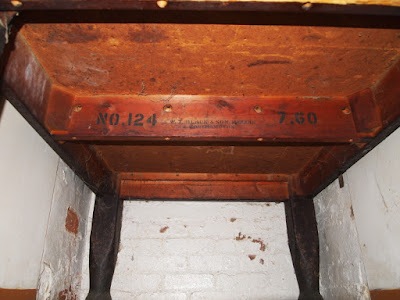Some of the early local and regional CAMRA pub guides can be useful documents to pub enthusiasts like myself. Dating from the 1970's onwards, these pocket-size guides would eventually cover most parts of the country, and at their best give a valuable insight into a tradition of pub-going which most pubs can only dream of now!
The actual pub descriptions are often perfunctory at best, the campaigning focus of CAMRA in those days being firmly rooted in the revival of real ale at a time when pubs were largely taken for granted! The Northamptonshire guide which I find most useful dates from the late 80's, a time which might now be regarded as the very beginnings of the current massive decline in pubs and pub going. This comparatively recent guide has much better descriptions than most, even the local Northamptonshire Skittles game was deemed important enough to feature wherever a table existed, sadly not always the case with CAMRA's current (and otherwise excellent) national pub guide Whatpub.
Though closures were much rarer back then, the late 80's and 90's were still a time of great change in the pub trade. The wholesale knocking-through of multi-room pubs was a particular concern, and inappropriate refurbishment was as common then as it is today. The descriptions in the Northants guide reflect this, sometimes in ways that seem unduly harsh in retrospect. The Boat Inn is a good example of this, the extensions and additions to the historic heart of the original pub described rather cruelly in the guide as being carbuncles!
Harsh indeed given the fate of so many similarly attractive village pubs in the intervening years. The writers of that pub guide must surely reflect on whether this beautiful thatched canalside pub would have survived at all had it not been for the investment and far-sighted business sense of the owners? That the original series of interlinked rooms survive to be enjoyed today is undoubtedly thanks to the success of the business overall. A honey-pot for families and diners which fully exploits the pubs attractive location, and yet remains entirely true to its origins as a humble bargees watering hole and village local.
You really have to take your hat off to the licensees of the Boat Inn. Less sympathetic owners would no doubt have opened out and spoilt the original interior to squeeze a few more tables in, assuming it even survived as a pub. And would a space have been retained for the old Northamptonshire Skittles Table in the bar? Doubtful in my view.
The Boat has been run by the same family for approaching 150 years, and in sympathetically modernising and extending the historical original, they have surely done local and visiting pub-goers a huge service. Indeed my only criticism of the interior is that you probably have to get there pretty early to bag a seat in the cosy older part, such is the popularity of the pub at all times of the year.
The Skittles Table, a 1960's W T Black & Son model, sits in its own ante-room off the old bar area. The table is missing the usual netted 'hood' designed to catch wayward throws, but this is not really required given that the table sits snugly in an alcove. I imagine it must come in for an awful lot of play from visitors to the pub, particularly the steady stream of leisure boaters with more time on their hands than most. Northamptonshire Table Skittles must be a local curiosity for many visitors, who no doubt require a little coaching in the throw, the rules of the game, and general skittling etiquette.
Several decades of use can take its toll on a Northants Skittles Table. The leatherwork is usually the first thing to go, the woodwork usually requiring little more than a new coat of paint. Table No.124 has been refurbished by A Pinkard of Kislingbury at some point in the past, a name which appears on many skittles tables in Northamptonshire, and probably the local repairer and refurbisher for most of the league tables in the Gayton League.








No comments:
Post a Comment